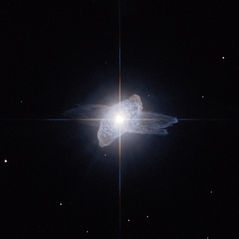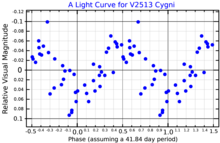 IRAS 19474+3119 | |
| Observation data Epoch J2000 Equinox J2000 | |
|---|---|
| Constellation | Cygnus |
| Right ascension | 19 49 29.5618 |
| Declination | +31° 27′ 16.249″ |
| Apparent magnitude (V) | 9.33 - 9.50 |
| Characteristics | |
| Evolutionary stage | Protoplanetary nebula |
| Spectral type | F3 Ibe |
| Variable type | SRd |
| Astrometry | |
| Proper motion (μ) | RA: −0.156 mas/yr Dec.: −1.684 mas/yr |
| Parallax (π) | 0.3159 ± 0.0209 mas |
| Distance | 4,900 pc |
| Details | |
| Mass | 0.63 M☉ |
| Radius | 58 R☉ |
| Luminosity | 8,300 L☉ |
| Surface gravity (log g) | 0.5 cgs |
| Temperature | 7,200 K |
| Metallicity | −0.25 dex |
| Other designations | |
| V2513 Cyg, BD+31°3797, HD 331319 | |
| Database references | |
| SIMBAD | data |
IRAS 19475+3119 is a protoplanetary nebula in the constellation of Cygnus, 15,000 light-years away. The central star, V2513 Cygni, is an F-type post-AGB star.
The brightest portion of the nebula shows a quadrupolar structure, with elongated bipolar lobes, all surrounded by a faint halo.

The distance is essentially unknown. Assumptions about the luminosity have been used to estimate the distance and other stellar parameters. At an assumed kinematical distance of 4.9 kpc, the luminosity is 8,300 L☉ and the radius 58 R☉. The star was originally at least 2.5 M☉ and is now 0.63 M☉. Assuming a luminosity of 3,500 L☉, the distance becomes 1.5 kpc. Estimates based on the oxygen spectral line strengths give much higher values luminosities with an absolute magnitude of at least −8.
In 2006, Vera P. Arkhipova et al. announced that IRAS 19475+3119 is a variable star. It was given its variable star designation, V2513 Cygni, in 2013. The star varies from about magnitude 9.33 to 9.50. A primary period of 41 days has been determined, but a slightly shorter secondary period leads to long beats causing variations in the amplitude and apparent period from year to year. The variations are caused by stellar pulsations, with the star being brightest when it is hottest. The temperature varies by up to 400 K.
References
- ^ Brown, A. G. A.; et al. (Gaia collaboration) (2021). "Gaia Early Data Release 3: Summary of the contents and survey properties". Astronomy & Astrophysics. 649: A1. arXiv:2012.01533. Bibcode:2021A&A...649A...1G. doi:10.1051/0004-6361/202039657. S2CID 227254300. (Erratum: doi:10.1051/0004-6361/202039657e). Gaia EDR3 record for this source at VizieR.
- ^ Samus, N. N.; Durlevich, O. V.; et al. (2009). "VizieR Online Data Catalog: General Catalogue of Variable Stars (Samus+ 2007-2013)". VizieR On-line Data Catalog: B/GCVS. Originally Published in: 2009yCat....102025S. 1. Bibcode:2009yCat....102025S.
- ^ Klochkova, V. G.; Panchuk, V. E.; Tavolzhanskaya, N. S. (2002). "HD 331319: A Post-AGB F Supergiant with He I Lines". Astronomy Letters. 28 (1): 49–62. Bibcode:2002AstL...28...49K. doi:10.1134/1.1434453. S2CID 120988304.
- ^ Hsu, Ming-Chien; Lee, Chin-Fei (2011). "An Envelope Disrupted by a Quadrupolar Outflow in the Pre-planetary Nebula IRAS 19475+3119". The Astrophysical Journal. 736 (1): 30. arXiv:1105.2410. Bibcode:2011ApJ...736...30H. doi:10.1088/0004-637X/736/1/30. S2CID 119192160.
- ^ Sahai, Raghvendra; Sánchez Contreras, Carmen; Morris, Mark; Claussen, Mark (2007). "A Quadrupolar Preplanetary Nebula: IRAS 19475+3119". The Astrophysical Journal. 658 (1): 410–422. Bibcode:2007ApJ...658..410S. doi:10.1086/511294. hdl:10261/191229.
- Hrivnak, Bruce J.; Van de Steene, Griet; Van Winckel, Hans; Lu, Wenxian; Sperauskas, Julius (December 2018). "Variability in Proto-planetary Nebulae. V. Velocity and Light Curve Analysis of IRAS 17436+5003, 18095+2704, and 19475+3119". The Astronomical Journal. 156 (6): 300. Bibcode:2018AJ....156..300H. doi:10.3847/1538-3881/aaee69.
- Vickers, Shane B.; Frew, David J.; Parker, Quentin A.; Bojičić, Ivan S. (2015). "New light on Galactic post-asymptotic giant branch stars - I. First distance catalogue". Monthly Notices of the Royal Astronomical Society. 447 (2): 1673. arXiv:1403.7230. Bibcode:2015MNRAS.447.1673V. doi:10.1093/mnras/stu2383. S2CID 119245776.
- Arkhipova, V. P.; Ikonnikova, N. P.; Komissarova, G. V.; Esipov, V. F. (January 2006). "Study of the IR-excess supergiant HD 331319". Astronomy Letters. 32 (1): 45–53. Bibcode:2006AstL...32...45A. doi:10.1134/S1063773706010075. Retrieved 13 December 2024.
- Kazarovets, E. V.; Samus, N. N.; Durlevich, O. V.; Kireeva, N. N.; Pastukhova, E. N. (April 2013). "The 80th Name-List of Variable Stars. Part III - RA 16h to 24h" (PDF). Information Bulletin on Variable Stars. 6052. Bibcode:2013IBVS.6052....1K. Retrieved 13 December 2024.
- Hrivnak, Bruce J.; Lu, Wenxian; Nault, Kristie A. (2015). "Variability in Proto-planetary Nebulae. IV. Light Curve Analysis of Four Oxygen-rich, F Spectral Type Objects". The Astronomical Journal. 149 (6): 184. arXiv:1503.09120. Bibcode:2015AJ....149..184H. doi:10.1088/0004-6256/149/6/184. S2CID 119266827.